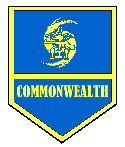Beta
Canum Venaticorum
BCV-4 remains the central pivot of
Commonwealth operations within the French Arm. It
provides a central location for the deployment of forces
throughout the Beta Canum Cluster in which the British
and Azanian colonies are located. In addition the
Dominion of New Africa retains the largest populations of
abandoned Kafer soldiers now dug into the depths of the
New African rain forest.
As a result the CEF presence on BCV-4
is divided into two major Corps, each composed of two
divisions and a number of independent brigades. II Corps
is dedicated to providing the Dominion and the wider
planet with a powerful manoeuvre warfare force in
addition to providing contingents for other tasks. V
Corps has recently been formed for the task of defending
the colony and prosecuting the war against the residual
Kafers in the so-called K-Zone.
Commonwealth forces on Beta Canum-4
have set up a range of Battle Schools to indoctrinate new
arrivals and to pass on good practise. The V Corps Patrol
School run by hard bitten veterans of the K-Zone, whilst
the Defence School passes on lessons learned by the New
African Resistance in the former occupied zones. All
battle schools on Beta Canum stress the prevailing belief
in the effectiveness of close quarter battle techniques
against Kafers in the initial stages of a contact. Ambush
and mine warfare skills are also stressed.
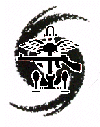
II (Commonwealth) Corps
II Corps is the main manoeuvre element
of the Commonwealth Expeditionary Forces, and due to the
multi-national nature of its units has taken on the
Commonwealth name. II Corps (then II (British) Corps)
moved up to Beowulf shortly after the fall of Kimanjano
and prepared for the defence of that colony as well as
possible offensive operations. II Corps had operational
command of all Commonwealth, French and German forces
involved in the 3rd Liberation and controlled most of the
subsequent operations.
With the creation of V Corps it now
concentrates of providing mobile defence for New Africa
as well as planning for further large scale operations
off-world for which it is tasked with providing command
and control. II Corps directly controls 2 armoured
divisions and three independent brigades and is equipped
with the most modern equipment available.
- Corps Recce Group
-
- 3rd Light Dragoons (18th Hussars)
(3 LD)
- 1st Bn, The Royal Greys (1 R
GREYS)
-
- 1st (Guards) Armoured Brigade
Group
-
- 1 Armd Bde is the only British
heavy armoured brigade deployed off Earth. In
fact the brigade has been heavily reinforced into
a substantial and powerful fighting force
including an extra assault hover-infantry
battalion and an air regiment. The Bde was
originally a part of the 1st (British) Armoured
Division and was reorganised and sent up-Arm
arriving on BC-4 in the second wave of forces. It
saw frequent action in urban clearance operations
across the colony. The brigade consists of 3
Household units from Britain, a Royal Tank
Regiment and a battalion of attached Dutch
Guards.
-
- 1st Life Guards (1 LG)
- 1st Royal Tank Regiment (1 RTR)
- 2nd Bn, The Coldstream Guards (2
COLD GDS)
- 2nd Bn, The Scots Guards (2 SG)
- 101 Bn, Guarde Regiment Fusiliers
Prinses Irene (101 NL GDS)
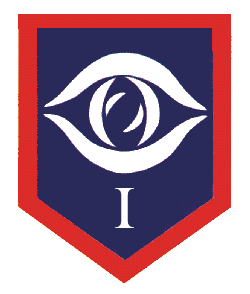 |
Full colour
badge of the 1st (Guards) Armoured Brigade. Designed by Rex Whistler and
first worn by the Guards Division of WW1 and the
Guards Armoured Division of WW2. Its use for
'Guards Armoured' formations was resumed in 2185.
This
badge is usually found on vehicles of the
brigade.
|
- 1 Canadian Armoured Brigade
Group
-
- 1 CABG is the main Canadian
contribution to the war effort and was
accompanied by its own dedicated starlift assets
that made the unit exceptionally strategically
mobile and a very valuable asset. 1 CABG was
involved in the first wave of landings on BCV-4
and saw some fierce action in the north of the
German Continent against experienced Kafer
manoeuvre units. The Brigade has been rotating
fresh soldiers into its major units and is
undergoing a intensive training program.
-
- Lord Strathcona's Horse (Royal
Canadians) (LStH)
- 1st Battalion, Princess Patricia's
Canadian Light Infantry (1 PPCLI)
- 3rd Battalion, Princess Louise's
Canadian Fusiliers (3 PLCF)
| The black
Maple Leaf of the Canadian Expeditionary Force is
almost universally worn by all Canadian service
personnel on the French Arm. This subdued version
is the most commonly seen in the Canadian
Armoured Brigade. |
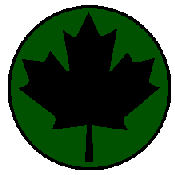 |
-
- 1 New African Special Duties
Brigade
-
- 1 NASD Bde has recently been
created by amalgamating the old Special Duties
Command and the remaining battalions of the New
African Legion. The brigade is unique in the NADF
in that all of its soldiers are regular volunteer
soldiers, either from the ranks of the New
African Army or from overseas volunteers into the
Legion.
-
- All of the battalions are lightly
equipped and trained for long duration, deep
penetration counter-Kafer operations. Whilst the
brigade is under the control of II Corps it
maintains a high operational pitch by rotating
through the K-Zone under V Corps OPCON.
Additionally the brigade's training cadres
undertake their final 'exercises' under
operational conditions in the K-Zone, the brigade
takes the concept of 'blooding' its soldiers very
literally.
-
- 15 Commando (15 CDO)
- Westmark Rifles (WEST RIFLES)
- 1st (Chasseur) Bn, The New African
Legion (1 NAL)
- 3rd (Hunter) Bn, The New African
Legion (3 NAL)
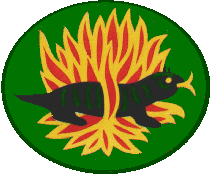 |
Inspired both
by a 20th Century Commando badge and the
indigenous Garoc Salamander (a hardy creature
that survives the intense biannual Grassland
fires). The Special Duties Brigade wears this
patch signifying their desire to go through fire
or suffer any torment to succeed in their
missions. |
7th (British) Armoured Division
7th Armd Div is a recently organised
division and was initially composed of the British Army's
crack independent Armoured Brigades. However since its
formation the battered 79 Armd Bde was sent back to
Beowulf to refit and rebuild, and was replaced by 9 Armd
Bde from 3rd Division. This change was much resented by
the other brigades in the division who saw themselves as
an elite and the presence of the Guards as diluting their
skills. Since their arrival feelings have relaxed
somewhat although it is still common for 9 Armd Bde to
work closely under Division HQ whilst the other two
brigades have more freedom of action.
- Divisional Recce Group
-
- 1st RGL Hussars (1 RGL H) (-B Sqn)
- 1st RGL Jaegers (1 RGL J)
(detached)
-
- 7th (British) Armoured Brigade
-
- 7 Armd Bde, the Desert Rats, were
an Earth based armoured reaction brigade that was
quickly re-roled for off-Earth fighting and
reached Beowulf just before the Fall of
Kimanjano. It was a key element in the 3rd
Liberation of Beta Canum, being the first Armd
Bde to be landed and subsequently involved in
much of the fighting on all four continents.
-
- B Sqn, 1st Recce Bn, Huzaren Prins
van Oranje (B/1 NL RECCE)
- 2nd Dragoons (2 D)
- 1st Bn, The Cheshire Regiment (1
CHESHIRE)
- 3rd Bn, The Queen's Regiment (3
QUEENS)
| The 7th
Armoured Brigade is descended from the famous 7th
Armoured Division that fought against the Afrika
Korps in the Western Desert Campaign in WW2. 7
Armd Bde continues to wear the easily
recognisable 'Desert Rat' or Jerboa symbol which
is ubiquitous throughout the brigade on uniforms,
vehicles and buildings. |
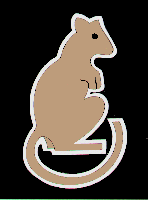 |
- 9th (Guards) Armoured Brigade
-
- 9 Armd Bde was a conventional
hover armoured bde and a part of 3 Armd Div on
Earth and was deployed with that Division to
Beowulf shortly after the Liberation commenced.
It was transferred to 7 Armd Div to replace the
badly damaged 79 Armd Bde that had been involved
in the fighting since the Invasion of Beta Canum.
The brigade includes two battalions from the
Household Division and so is designated a Guards
brigade and uses the 'Guards Armoured' badge.
-
- Y Sqn, 10th/11th Hussars (Y 10/11
H)
- 3rd Dragoons (3 D)
- 1st Bn, The Grenadier Guards (1
GREN GDS)
- 1st Bn, The Irish Guards (1 IG)
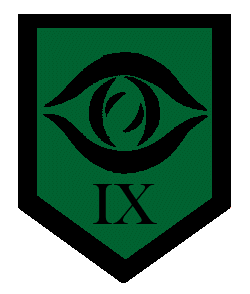 |
Subdued 9th
(Guards) Armoured Brigade shoulder patch. A
similar patch is worn by 1 Armd Bde. The
10th/11th Hussars attached to the brigade
continue to wear their 7 Armd Bde patches. |
- 1st RGL Brigade
-
- 1 RGL Bde is manned by soldiers of
Britain's Royal German Legion, composed of
foreign (mostly German) troops recruited in to
the British Army. Most are veteran soldiers and
the brigade has an exemplary reputation for its
battle skills. The RGL Bde was deployed on Beta
Canum soon after the Desert Rats and involved in
many of the same actions especially on the German
Continent. Elements of the Bde also saw
substantial action on Crater and Dunkleheim.
-
- B Sqn, 1st RGL Hussars (B 1 RGL H)
- 1st RGL Dragoons 'Kampfgruppe
Reinhardt' (1 RGL D)
- 1st RGL Line 'Kampfgruppe
Paterson' (1 RGL L)
- 3rd RGL Line 'Kampfgruppe
Jansen' (3 RGL L)
11th (Commonwealth) Armoured
Division
The Wellon government was one of the
first to offer troops to the CEF and although the Wellon
Expeditionary Force took some time to build up the Wellon
contribution soon became a significant one. One of the
contributions was the offer of a fully functioning
divisional HQ from 11 (Wellon) Armd Div, which was soon
accepted for inclusion in the follow on forces on Beta
Canum. The Div HQ arrived on Beta Canum in September 2302
after build-up training on Beowulf, and soon proved its
worth in co-ordinating previously uncoordinated brigade
groups.
The division has had a variety of units
under its control, including at different times British,
Canadian, Alicia, Australian, German and New African
Brigades. Its commander made the immediate decision on
arrival at BCV-4 to adopt the 'Commonwealth' tag in the
divisional title. 11 Armd Div, usually known and referred
to as the 'Commonwealth Armoured', has acquired a fine
name for itself resting on the skills of its brigades,
the high quality of its divisional staff composed of the
finest Wellonese officers and attached Commonwealth
personnel. The division currently commands brigades from
Wellon, Alicia and a newly organised New African brigade.
- Divisional Recce Group
-
- The Commonwealth Armoured's DRG is
composed of a Wellonese armoured recce regiment
and a British close recce battalion.
-
- The Lord Woolf's Dragoon Guards
(LWDG)
- 1st Bn, The Scottish Rifles (1 SR)
-
- 1 (Wellon) Armoured Brigade
-
- 1 Wellon Armd Bde is a pre-War
Wellon Army formation that was amongst the first
to be re-roled for possible deployment with the
Wellon Expeditionary Force. Re-equipped and
trained to a high pitch before leaving Tirane,
this formation has earned itself an excellent
reputation since its arrival on Beta Canum.
Internal rivalry in the brigade centres on the
cultural differences between the highly
disciplined blue-bloods of the Wellon Guards and
the heavily tattooed and often ritually scarred
mavericks of the Royal Southerns.
-
- 6th Wellon Armoured Regiment (6
WAR)
- 2nd Bn, The Wellon Guards (2
Wellon Gds)
- 1st Bn, The Royal Southern
Regiment (1 R South R)
| Wellon's
Armoured Brigades generally have badges based
either on mythical creatures or native Wellonese
fauna. 1 (Wellon) Armd Bde is no exception and
has taken the afanc, a vicious bear-like creature
found in the northern Tiralbion, as its symbol. This is applied worn
both as a shoulder patch and as shown here as a
silhouette. This is found on every vehicle in the
brigade.
|
 |
-
- 1 New African Armoured Brigade
-
- 1 NA Armd Bde is a recently
organised formation designed to give the NADF its
own integral manoeuvre warfare capacity. Its
constituent battalions have had 6 months of
intensive training for their new role and have
received the latest armoured vehicles fresh from
Alician factories. The brigade has yet to see
action as a formation and hopes to be blooded in
the K-Zone soon, but has been progressing well on
exercises so far.
-
- The Tiger Hussars (TH)
- 2nd Bn, The New African Light
Infantry (2 NALI)
- 1st Bn, The Mavericks (New
Middlesex Irish) (1 MAV)
-
- 8th (Alicia) Brigade
-
- 8 Bde is the primary element of
the Alician Expeditionary Force. Organised during
the darkest days of the Invasion it is composed
of three infantry-heavy armoured battlegroups and
manned by the some of the finest Alician
soldiers. Although only a part of the follow on
forces during the Liberation of BCV-4 it's skills
at night fighting and disciplined, tactically
aggressive fighting style has made it
increasingly important and highly regarded asset
by II Corps HQ.
-
- 1st Bn, The Duke of Alicia's Own
Regiment (1 DAO)
- 2nd Bn, Royal Alician Marines (2
RAM)
- 1st Bn, The Dragon Regiment of
Alicia (1 DRAGON)
V (New African) Corps
V Corps, often referred to in the New
African press as the Vengeance Corps, has been recently
created in order to provide dedicated defensive capacity
for the British Continent. It also has an overview remit
in relation to the reserve and volunteer formations of
the New African Defence Forces. However its primary
mission is the conduct of operations against the residual
Kafer presence in the K-Zone. In pursuit of this aim the
Corps is composed of two infantry heavy Light Divisions,
who conduct high intensity patrolling and Fireforce
counter-Kafer operations. V Corps also has three
International Brigades under OPCON who also take part in
patrolling operations in the K-Zone and in providing
reaction forces against Kafer sallies from the K-Zone.
- International (East African)
Brigade
-
- The East African Brigade was the
first of the multi-national International
Brigades, and fell victim to virtually all of the
problems suffered by the others. Without access
to military starlift and with much civilian
shipping impressed by the starfaring powers the
brigade was effectively stranded on Earth. Only
when much of the brigade's independence of action
had been bargained away was it finally moved up
arm in November of 2302 as part of the
Commonwealth forces and deployed to Beta Canum.
The brigade has suffered from poor flow of
supplies and casualty replacements from the home
nations and most units are seriously
understrength and two have amalgamated.
-
- The Brigade Commander has also
made herself unpopular with higher command with
her repeated media pronouncements and perceived
egotism. In spite of these problems the East
African Brigade has welded into an effective and
reliable military force although it lacks the
equipment and training for high intensity
manoeuvre operations.
-
- 'C' Company, Mtondo Scouts
(Malawi)
- 9th 'Kasungu' Ranger Battalion
(Malawi)
- 1st/2nd Askari za Dunia Regiment
(1st/2nd AzD) (Tanzania)
- 2nd Bn, The Kenyan Rifles (2 KR)
(Kenya)
-
- International (Southern Africa)
Brigade
-
- The Southern Africa Brigade was
perhaps the least haphazardly organised of the
International Brigades. It is composed of crack
light infantry units drawn from amongst Azanian
satellite nations and organised on standard
Azanian lines. As a defacto part of the Azanian
military it saw service on Kimanjano and Joi
before being deployed to Beta Canum to operate
against the K-Zone. The Southern Africa Brigade
is tough, well trained and with excellent
operational experience.
-
- 1 Commando Battalion (Zimbabwe)
- Combat Group 12 (Namibia)
- 2 Batalhão Cacadores
Pára-quedistas Especial (Angola)
-
- International (Indian
Sub-Continent) Brigade
-
- The Indian Brigade has had one of
the most convoluted gestation period having been
put together by normally warring Indian States.
The project was nearly stillborn on a number of
occasions but eventually got underway and was
swiftly sent to Beowulf, partly to get out of the
political arena. Surprising this mechanised
brigade gelled quickly with the individual
continents respecting each others skills. The
unit deployed to Beta Canum in February 2303 and
was on operations in the K-Zone soon after.
-
- 1st Bombay Armoured Regiment
(Hodson's Horse) (Bombay)
- 6th Bn, The Guards (India)
- 2nd Bn, The Sikh Regiment (Punjab)
- 1st Bn, The 5th Independent Gorkha
Rifles (Royal Frontier Force) (Nepal)
1st (Commonwealth) Light Division
1 Light Div is the most combat
experienced division in the British orbat, having seen
action on Beta Canum since the initial Kafer Invasion and
taken part in every major operation since then. Today it
retains only one of its original brigades but has held
onto a vastly experienced divisional staff and its
impressive esprit de corps, styling itself as The
Division. 1 Light Div has a complement of veteran
British and Gurkha infantrymen and aggressive
Anglo-Wellonese paratroopers and has a adopted the
prestigeous Commonwealth tag.
- Divisional Recce Group
-
- 1 Light Div Recce Gp is composed
of two excellent formations. 3 RTR is normally
deployed in support of 1 Cdo Div and its
personnel are entirely commando trained, equipped
with Montgomery HBT's it is capable of both recce
and assault tasks. Whilst the all volunteer
Tarakiwa Rangers battalion from New Zealand has
proved immensely capable in the close recce,
light infantry and raiding roles.
-
- 3rd Royal Tank Regiment (Commando)
(3 RTR(Cdo))
- The Tarakiwa Rangers (NZ)
-
- 2nd (British) Light Brigade
-
- 2 Light Bde was a part of 1 Light
Div during the initial invasion and has remained
with it ever since. Badly savaged in the Chill
Valley campaign it's units rebuilt, integrating
New African volunteers into their ranks. The Bde
has seen repeated action since then and after the
Liberation was brought back up to strength with
BCR drafts whilst one battalion was rotated back
to Earth as it was so understrength. The brigade
has a hard fighting and hard drinking reputation
and has been due for rotation back to the core
but GOC 1 Light Div insists on retaining its
services. Some divisional and brigade staff fear
that the brigade is becoming stale however.
-
- 2nd Bn, The Yorkshire Regiment (2
YORKS)
- 1st Bn, The Black Watch (1 BW)
- 1st Bn, The Royal Greenjackets (1
RGJ)
-
- 1st Gurkha Brigade
-
- 1 Gurkha Bde was deployed on Joi
during the Invasion and was called upon to fight
in the bitter campaign to scour Japanese and
German colonies of Kafer troops. The Bde
languished until September 2302 when it was
called upon to replace 1 Light Bde on Beta Canum.
The Bde's disciplined patrolling, high body
counts and willingness to use their Kukhri knives
on the Kafers have endeared them to the sometimes
cynical New African public.
-
- 1st Bn, The Royal Gurkha Rifles (1
RGR)
- 3rd Bn, The Royal Gurkha Rifles (3
RGR)
- 5th Bn, The Royal Gurkha Rifles (5
RGR)
-
- 1 (Wellon) Airmobile Brigade
-
- This Wellonese Bde was an early
addition to the Wellonese Expeditionary Force and
saw extensive training before leaving Tirane. It
is well equipped with aircraft and is most often
used to provide Fireforce support to the other
two brigades, although it also undertakes
patrolling operations. The brigade is aggressive,
flamboyant and media savvy and has proved an
excellent addition to 1 Light Div.
-
- 3rd Bn, The Parachute Regiment (3
PARA)
- 101st Bn, The Royal Wellon
Airmobile Regiment (101 RWAR)
- 103rd Bn, The Royal Wellon
Airmobile Regiment (103 RWAR)
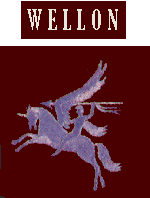 |
The Royal
Wellon Airmobile Regiment is descended from the
three battalions of the Parachute Regiment raised
on Wellon in the early years of the colony. On
Home Rule these units were passed onto the new
Wellon Army and were renamed. This change was
unpopular in the RWAR, however the Wellonese
retained the pegasus flash surmounted by the
usual 'Wellon' national flash. |
-
3rd (New African) Light Division
3 Light Div is the main fighting
formation in the New African Defence Force and is
deployed alongside 1 Light Div in patrolling and
operating against the K-Zone. If the Division's national
servicemen sometimes lack the general skills and finesse
of the solders in 1 Light Div, they make up for it with
implacable hatred of the Kafers and a burning desire for
revenge.
The Division is composed of all of the
NADF's reformed pre-War regular battalions and these
units retain strong cadres of experienced officers and
NCOs to steady the young national servicemen. Divisional
command staff has come from the ranks of the original New
African Light Bde that fought under 1 Light Div during
the Occupation.
- Divisional Recce Group
-
- Jameson's Scouts (J SCOUTS)
-
- 1 New African Light Brigade
-
- 1st Bn, The New African Light
Infantry (1 NALI)
- 1st Bn, The New Middlesex Scottish
(1 NMS)
- 3rd Bn, The New African Regiment
(3 NAR)
| The New
African Light Brigades all use a variation on the
theme of the phoenix, denoting the rebirth of New
Africa after the Kafer Occupation. The numeral
above the phoenix represents the brigade, whilst
the numeral '3' represents the 3rd Light Division
to which the brigade is normally attached. |
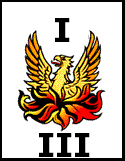 |
-
- 2 New African Light Brigade
-
- 1st Bn, The New African Regiment
(1 NAR)
- 4th Bn, The New African Regiment
(4 NAR)
- 6th Bn, The New African Regiment
(6 NAR)
-
- 3 New African Light Brigade
-
- 1st Bn, The Royal Volunteer Rifle
Corps of New Africa (1 RVRC)
- 2nd Bn, The New African Regiment
(2 NAR)
- 7th Bn, The New African Regiment
(7 NAR)
NEXT
|









